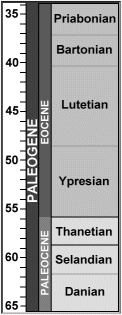| |
In 2005, Cappetta & Nolf erected a new genus, Brachycarcharias, for teeth commonly attributed to the species lerichei but attributed to various genera. For example, elasmo.com recognized the tooth-set design as sand tiger-like, but continued to include these teeth under the genus Serratolamna. Acknowledging this distinct tooth-design as long overdue, it was rapidly embraced by this website.

Brachycarcharias lerichei (CASIER, 1946) is present in the Palaeocene (Brightseat & Aquia) and much more abundant in the Eocene (Nanjemoy) exposures of the Chesapeake region. Further south, they can be found in the Castle Hayne Formation (Lutetian) of North Carolina.
B. lerichei is rare in the middle Thanetian, more common in the upper Thanetian of France (Smith et al, 1999) and is extremely abundant in the Ypresian (Casier, 1946) and the Lutetian of Belgium (Leriche, 1905).
Depending on tooth position and age, the teeth of this species can be readily identified or cloaked in "sand tiger homogeniosity". Teeth tend to be striated, but those from mature individuals may have have smooth crowns and more triangular primary cusplets on each shoulder (the secondary cusplet may be lost enrtirely). Posterior teeth may have a third cusplet. Juvenile teeth with narrower cusplets are more reminiscent of Carcharias-like species and / or Striatolamia, making identifications more difficult.
In the Castle Hayne of North Carolina (Lutetian/Bartonian), a second Brachycarcharias tooth-design is present -- a multi-cuspleted version. These teeth are similar to the lerichei design and some of the teeth reported from the Eocene of Morocco.
Selected References (additional in Bibliography)
Cappetta, H & Nolf, D, 2005. Revision de quelques Odontaspidae (Neoselachii: Lamniformes) du Paleocene et de l'Eocene du Bassin de la mer du Nord Bulletin de l'institut Royal des Sciences Naturelles de Belgique, Sciences de la Terre 75: 237-266.
Casier, E., 1946. La faune ichthyologique de l'Yprésien de la Belgique. Mémoires du Musée royal d'Histoire naturelle de Belgique, 104: 1-267.
Leriche, M., 1905. Les poissons tertiaires de la Belgique. II. Les poissons éocènes. Mém. Mus. Roy. Hist. Natur. Belg., 11(3): 49-228.
Smith, R., Smith, T. & Steurbaut, E. 1999. Les élasmobranches de la transition Paléocène-Eocène de Dormaal (Belgique) : implications biostratigraphiques et paléobiogéographiques. Bull. Soc. Geol. France, t.170 (3): 327-334.
|